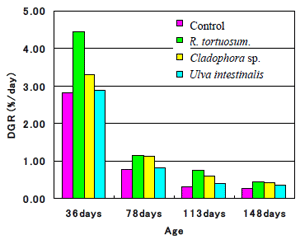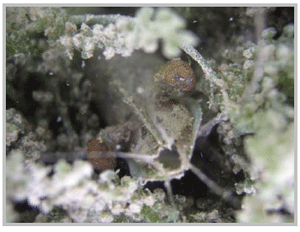A newly developed co-culture system between the giant tiger prawn and two species of algae
Description
Japan ranks as the second largest shrimp importer in the world, next to the United States (US). It imports about 90% of its total demand and most of the imported shrimps come from Southeast Asian countries. However, these countries have some problems with regards to their intensive shrimp cultures, such as eutrophication and outbreak of diseases. Hence, the current production of the giant tiger prawn (Penaeus monodon) which is an indigenous species in Southeast Asia is decreasing remarkably.
Our intent is to research and develop a P. monodon co-culture system which is simple, low cost, has minimum negative environmental impact and able to produce safe and high quality shrimps, in collaboration with Kasetsart University in Thailand. We are attempting to use algae to develop a new co-culture system for shrimp farms in Southeast Asia, where the majority of enterprises are small-scale. In our co-culture system for P. monodon, we selected Rhizoclonium tortuosum, a green filamentous alga which is commonly discarded by shrimp farmers due to their belief that it suppresses shrimp growth, and Caulerpa lentillifera which is a commercial alga in Japan and Philippines. R. tortuosum can grow in salinities ranging from 10-50 ppt. and temperatures of 20-30℃. C. lentillifera can adapt to salinities of 18-38 ppt.
Even when fed to satiation with artificial feeds, shrimps continued to graze on R. tortuosum (Fig. 1). And C. lentillifera serves as an effective protective shelter for the grown shrimps (Fig. 2). The water temperature inside the algae is stable and usually ranges at 1℃ less than the water surrounding them in the shrimp pond. Moreover, these algae have high abilities for the uptake of nitrogen existing as ammonia in the culture water. Shrimp growth is actually promoted by these algae.
After the outbreak of the yellow-head virus (YHV)disease which usually assures a 100% mortality rate, 10% of the shrimps survived in co-cultivation with these algae. It is thought that the stable environment and enhanced immunity offered by these algae for P. monodon allowed them to survive. The remaining shrimps grew to approximately 50 g. after two months of the YHV disease outbreak. In addition, production efficiency was improved by co-cultivation with the two algae.
Our data suggests that these algae are useful in shrimp cultures. It is concluded that the co-culture system incorporating these algae is a feasible method for maintaining the sustainability and high productivity of shrimp aquaculture in Southeast Asia.
Figure, table
-
Fig.1 Daily growth rate of shrimps supplied with the different algae -
Fig.2 A giant tiger prawn in a co-culture pond with the algae -
-
- Affiliation
-
Japan International Research Center for Agricultural Sciences Fisheries Division
- Term of research
-
FY2007(FY2006~2010)
- Responsible researcher
-
HAMANO Kaoru ( Fisheries Division )
Tsutsui Isao ( Fisheries Division )
KAKEN Researcher No.: 80425529SRISAPOOME Prapansak ( Kasetsart University )
Aue-umneoy Dusit ( King Mongkut's Institute of Technology Ladkrabang )
- ほか
- Publication, etc.
-
Hamano, K., Aue-Umnuoy, D., Srisapoome, P. and Tsutsui, I. (2007): Profitable environmental remediation with seaweeds in an intensive marine shrimp sulture. Abstract of XIXth International Seaweed Symposium, 155
Tsutsui, I., Aue-Umnuoy, D., Srisapoome, P. and Hamano, K. (2007): Possible implications on the co-cultivation on black tiger shrimp and clasophoraceae species on a southeast asian shrimp farm. Abstract of XIXth International Seaweed Symposium, 77
- Japanese PDF
-
2007_seikajouhou_A4_ja_Part19.pdf544.92 KB


